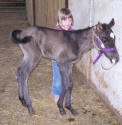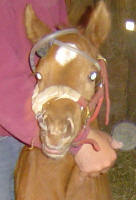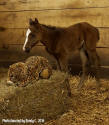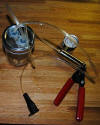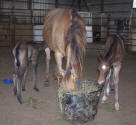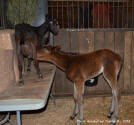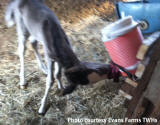

Raising an Orphan Foal
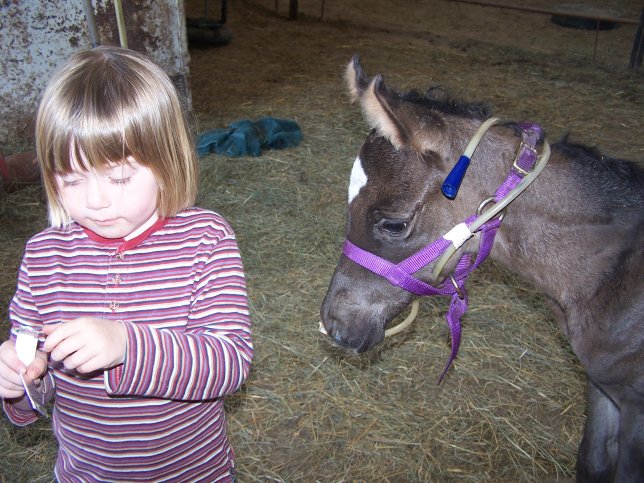
In 2008, we learned the hard way that sometimes, nature isn't kind to foals. Whether a mare refuses her foal, doesn't have milk, or dies during/after birthing, the odds are stacked against an orphan foal. We aren't experts about this, but I wanted to share the tips we were given during our ordeal in one location so maybe it will be easier for others to get or keep their foal going in the event of this kind of emergency. We spent precious time searching for info, because the search engines did not give us "one good page of tips" that we could get most of our info from.
We also want collect and add more tips, so if you have tips that I have forgotten to put here or that we don't know about, please e-mail us with your ideas. The more ideas people have in their arsenals to help them with this type of situation, the better their success might be.
We are not experts, and are just sharing tips we
received from others who have been in this situation.
These tips are not in chronological order of what you should try.
They are merely a collection
of ideas we learned or received from others during our orphan issue.
Consult your vet immediately if you have an orphan issue.
Preparing for an Emergency Before It Happens
-
Each time you have a new foal, milk some of the mare's colostrum in the first 12 to 24 hours. Taking 8 ounces from each mare should not hurt her current foal in most cases after her foal has nursed well several times. It takes a quart or more (please check a reliable source to learn proper amount) to help a newborn foal, so you'll need plenty on hand. Put it inside two freezer ziploc bags or freezer-safe containers (double wrapping might help it store longer without freezer burn).
-
Other colostrum sources: Goat colostrum is a fairly good substitute, but not as good as true mare colostrum. For mare colostrum, try:
University of MN
Hagyard Equine Medical Institute in Lexington, KY
Save some of your own each time possible after mares foal. -
Have Domperidone/Equitox (equidone) on hand, or know where to get it immediately. We have it here always, and if we think a mare is close to foaling and has not developed a bag, we give it to her to help her prepare to make milk. Some of our local vets have never heard of it, and some don't carry it. So, know where you can get some!
-
Have Serramune on hand. It is not colostrum, but might help.
-
Have Oxytocin on hand. It's very cheap...maybe $13 for a 100 cc bottle that would provide a LOT of shots. This is good for any mare after foaling to help her uterus contract, but also helps mares with milk "let down" for their foals or for you to express milk. Some think that giving 2 cc's to a mare that refuses to let her foal nurse will change her mind. NOTE: Contact your veterinarian before giving any amount!
-
Click here to e-mail another tip for this section, or click here to send us a photo to illustrate. You must be the owner of the photo if you'd like to see it on this page.
Urgent Care
-
The foal must get colostrum within the first 24 to 48 hours, and multiple doses of it. Horse colostrum can not be manufactured, so this requires advanced preparation.
-
Prevent dehydration with IV fluids and/or stomach tube. Once a foal is 12 hours old, it will really be needing some assistance. IV fluids, sub-cutaneous fluids, or bottled colostrum will help prevent the foal from getting so far down that it can't recover. Our vet put a stomach tube in, wrapped tape on it with a tag sticking out, and stitched that tag of cloth tape to our foal's nose. That kept the tube in for 2 days, allowing us to feed him to prevent dehydration. Another option is to run a stitch through the nose and up to the noseband of the foal's halter. See photos above.
-
Some people recommended a vitamin B12 boost.
-
Click here to e-mail another tip for this section, or click here to send us a photo to illustrate. You must be the owner of the photo if you'd like to see it on this page.
Tips for the First Day
-
Get colostrum into the foal. This may require bottle feeding, force feeding with a large syringe, or finding a mare that foaled the same day.
-
Contact your vet to put him/her on notice that you may be needing help.
-
Make an appointment to have your foal's IgG levels checked. If the foal didn't get proper transfer if antibodies from colostrum, you may need to do a transfusion to keep the foal alive long term.
-
Some people recommended "Nurse Mate", which is a first milk supplement and appetite stimulator in an acidified paste for newborn foals. It also contains a source of live, naturally occurring microorganisms. It can be found online at several catalog sites.
-
Get some probiotics. The Foal Lac label suggests giving probiotics on two separate days in the first week. Be prepared with these by obtaining them if you don't already have them on hand. In a pinch, you can try plain yogurt with active cultures. But possibly an equine-specific probiotic paste might be the best. If the foal's intestinal flora are off kilter, you could have serious problems! Don't leave this step out.
-
Comfort....Randy C. emailed us in 2016 that giving his orphan filly a large stuffed animal to simulate another animal in the stall helped to comfort her.
-
Click here to e-mail another tip for this section, or click here to send us a photo to illustrate. You must be the owner of the photo if you'd like to see it on this page.
How to Milk a Mare (for colostrum or milk)
Tips for Milking Mares

-
Try using a baby bottle liner (not the drop in kind, though they'll work in a different way) to milk. It can actually fit right on the teat and you can milk the mare through the soft plastic.
-
Give the mare a little oxytocin (consult your vet) to help her drop her milk down 5 minutes before milking her. We used 1/2 to 1 cc per quarter horse sized mare.
-
Cut the end off a syringe (try 60 and/or 30 cc). Put the plunger into the wrong end, and fit the "handle" end on the teat. Gently draw back on the syringe to express milk. It's hard to pull, but does work. Just don't pull too hard at the end and pull the plunger out, as you'll lose your hard-earned milk (yeah...I did that).
-
There is a commercial pump for milking mares, but it's costly. I bought one from Dansha Farms for our goats, and it worked on our mare. BUT, the battery was junk, and it died after about 1 minute (used it about 20 times for a dairy goat the previous year). Or, make your own (see instructions below this bulleted list).
-
Click here to e-mail another tip for this section, or click here to send us a photo to illustrate. You must be the owner of the photo if you'd like to see it on this page.
Homemade Mare Milker
More info coming soon
-
1-hand vacuum (for testing brake lines).
-
Tubing
-
Grommets
-
Silicone
-
Mason jar
-
Lamb nipple (may need to stretch this over part of a syringe if it collapses onto itself, or try a sturdier nipple).
Surrogate Mothers
-
Don't discount a mare with an older foal. Mares with newborn foals might be too worried about their foals. Mares with older foals might be more relaxed about motherhood. Try them all! But protect yourself from injury, as some mares will violently refuse.
-
To get another mare to accept a foal can be tricky or easy, depending upon the mare. Rubbing vanilla on the foal and the mare's nose to make them smell the same can help. Using a tranquilizer (such as Ace) might be needed, as well as a twitch or lip chain for a few days. Giving 2 cc's of oxytocin may help (if she is not pregnant from a recent rebreeding).
-
A mare without a foal can become a nurse mare, but it requires hormone manipulation. It could be as simple as Domperidone (equidone) paste for a few days to bring in milk, or might require more extensive assistance. Contact your vet.
-
Vaginal/cervical stimulation can help mares accept a foal. Massage the cervix for 2 minutes each time, twice, 10 minutes apart. Click here for details.
-
A large goat (such as a nubian) can make an excellent mother, and goats have raised many foals. Provide a couple straw bales for her to jump up on. Once the foal learns to nurse from the goat, they'll act just like family.
-
Click here to e-mail another tip for this section, or click here to send us a photo to illustrate. You must be the owner of the photo if you'd like to see it on this page.
Tips for Bottle Feeding Foals
-
Find a good-quality milk replacer. Foal-Lac works, but Buckeye and Progressive Nutrition make a much better replacer. We raised one of our stallions on the Progressive Nutrition milk replacer from 2 weeks of age after she coliced, and he looked as good as our foals on their dams. It's also good for 12 hours, and tastes so good they drink from a bucket, which eliminates the need for bottle feeding every couple hours!
-
In an emergency, you can make a short-term replacer just to keep the baby going:
1 gallon of milk
1 cup of buttermilk (this contains active cultures to help digestion)
1 can evaporated milk
1/2 cup of corn syrup
-
Most foals prefer a lamb nipple rather than a calf nipple. A human baby bottle nipple that is thin/flat in the middle and larger at the tip has also been known to work.
We have had NO luck with lamb nipples, but have instant luck with "Pritchard" nipples. We order online, but some vets and farm supply stores carry them for lambs and goat kids. -
Surround the nipple with soft material (suede, a towel, etc.) to simulate the mare's udder if needed.
-
Hold the bottle near your underarm so the foal can root on something. The stimulation of feeling something soft on his face helps him feel like he is nursing an actual mare. Rub that material on his dam or another nursing mare to get some scent on it if you have trouble.
-
The milk must be warm and fresh to train him to "want" it. You may waste some milk replacer, but most foals won't drink cold milk. You do what you have to do!
-
Most lamb nipples' holes are a little too small. You might have to enlarge it a bit.
-
Try putting a lamb's nipple on a 60 cc syringe to help train him to the nipple. It's easier to hold a syringe, and you can push the plunger to force milk into the foal's mouth, encouraging him to swallow and suck.
-
If the foal successfully learns to suck a bottle, you can move him to an "Igloo Cooler Momma" hopefully. This is a stroke of genius from whomever figured it out! It will reduce the numbers of times per day that you have to feed, as the cooler will keep milk fresh longer and is "always available." It consists of an Igloo cooler with the spigot removed, PVC pipe screwed into the hold, and a lamb's nipple placed over the PVC pipe.
1.5 gallon Igloo cooler
2" or 4" PVC screw on pipe (this pipe should be slightly smaller where it screws into the cooler. Take the cooler and nipple with you to the hardware store to make sure you get the right size).
A hose clamp (or zip ties) that will fit over this to secure the nipple
Goat's/lamb's nipples (one for each week of expected use)
Bungee cords/wires/ropes to attach it to a fence
4 small lunchbox freezer packs-these can keep milk fresher and also occupy space in the cooler bottom so that there is less milk waste
Unscrew the spout on the cooler and remove the plastic nut on the inside.
Screw the PVC pipe into the threads on the cooler with the plastic nut securing it on the inside
Fit the lamb's nipple over the end about 3/4 on the end of the PVC pipe. Clamp it on.
Adjust your nipple flow by opening up the 'x' on the nipple tip. The milk will drip if you open this up too much. Test the milk flow. This is a tight fit and you may need to use pliers to attach.
Place the cooler at normal nursing height. If it is not correctly placed, the foal could aspirate.
A brick in the bottom helps displace the milk replacer so less is wasted. If you use this method, Buckeye or Progressive make a milk replacer that is good for 12 hours without spoiling. Once you get the foal going on a bucket, this saves a LOT of time, because you don't have to make new milk every 2 or 3 hours. See photos here: http://www.mountainviewrescue.com/igloo.htm (I believe this cooler is secured higher than recommended, but you can get the idea).
http://www.shortassets.com/igloo.htm
-
Use a soft plastic pop bottle with the lamb nipple. This allows you to squeeze gently to force a bit of milk into the foal's mouth while trying to get him to suck on the bottle.
-
Dip your fingers in milk and try to get him to suck on your fingers if he won't nurse from the bottle at first.
-
Click here to e-mail another tip for this section, or click here to send us a photo to illustrate. You must be the owner of the photo if you'd like to see it on this page.
Tips for Bucket Feeding Foals
-
Milk must be warm to train the foal to drink from a bucket. You'll waste some, but it's necessary to keep what is in the bucket warm until the foal leans to want to drink it.
-
Buckeye or Progressive Nutrition make a milk replacer that is good for 12 hours without spoiling (from what I've heard). Once you get the foal going on a bucket, this saves a LOT of time, because you don't have to make new milk every 2 or 3 hours. I have now used Progressive Nutrition's milk replacer twice, and can't recommend it highly enough!
-
Repeatedly dip the foal's muzzle in the milk to get him to lick his lips and taste it. One person said they had good luck putting the bowl's edge into the foal's mouth, because he'd suck on the bowl and get some milk as well. That helped him learn to drink from the bowl, and then he learned to put his whole muzzle in the bowl to drink. Then, onward to a bucket!
-
Joycelyn wrote to us with this tip: "Best tip I've heard for getting them to drink from a bucket is to get them to suck on your finger while you slowly lower it into the bucket. As your finger submerges, angle your finger to break the seal enough so they will suck in a bit of milk around the sides of your finger. The milk must be warm the first few times you do this. You have to it a bunch of times, but eventually they will only chase your finger to the milk, and then, after a while, they will go to the bucket when you bring it in."
-
Click here to e-mail another tip for this section, or click here to send us a photo to illustrate. You must be the owner of the photo if you'd like to see it on this page.
Down the Road
-
Check into feeding Foal Lac pellets, or another early foal solid supplement. The Foal Lac pellets "melt in the mouth" (I wonder if they look like M&M's? ha ha!) and might help reduce the amount of milk replacer needed.
-
A foal raised on milk replacer might not look good as a weanling, but will catch up. However, I have heard of some mule foals and quarter horse foals raised on Progressive Nutrition's milk replacer that won halter competitions and futurities!
-
Click here to e-mail another tip for this section, or click here to send us a photo to illustrate. You must be the owner of the photo if you'd like to see it on this page.
Links
Photos Wanted
Click
here to e-mail photos to us.
(You must be the owner of the photo)
In order to provide decoration for this page to make it more interesting and also to help people visualize during their emergency, we'd love to receive related photos. Please only send your photo to us if you own the rights to the photo. Do not send photos you've taken from other peoples' web sites. This is an educational page...we are not earning money from it. So, we can't pay you for your photos. Some pictures (off the top of my head) that might be helpful include:
-
A picture of your Igloo cooler made into a foal feeder.
-
A foal nursing from a goat
-
A mare nursing two foals that are noticeably different in age
-
Others related to the content
This page last updated
08/10/20
If you notice this date being 2 years or older, please let
us know that we need to check out this page!


Home Horses For Sale Stallions Mares Foals Blog Color Genetics Riding Horses Site Map Contact Us

Toni Perdew
Bedford, Iowa
toni@grullablue.com
712-370-0851 cell, before 9 p.m. CST
![]()
www.facebook.com/CedarRidgeQuarterHorses
Web design by
CR
Equine Sites.
All rights reserved. Graphics are watermarked for copyright protection.
Terms of Use

